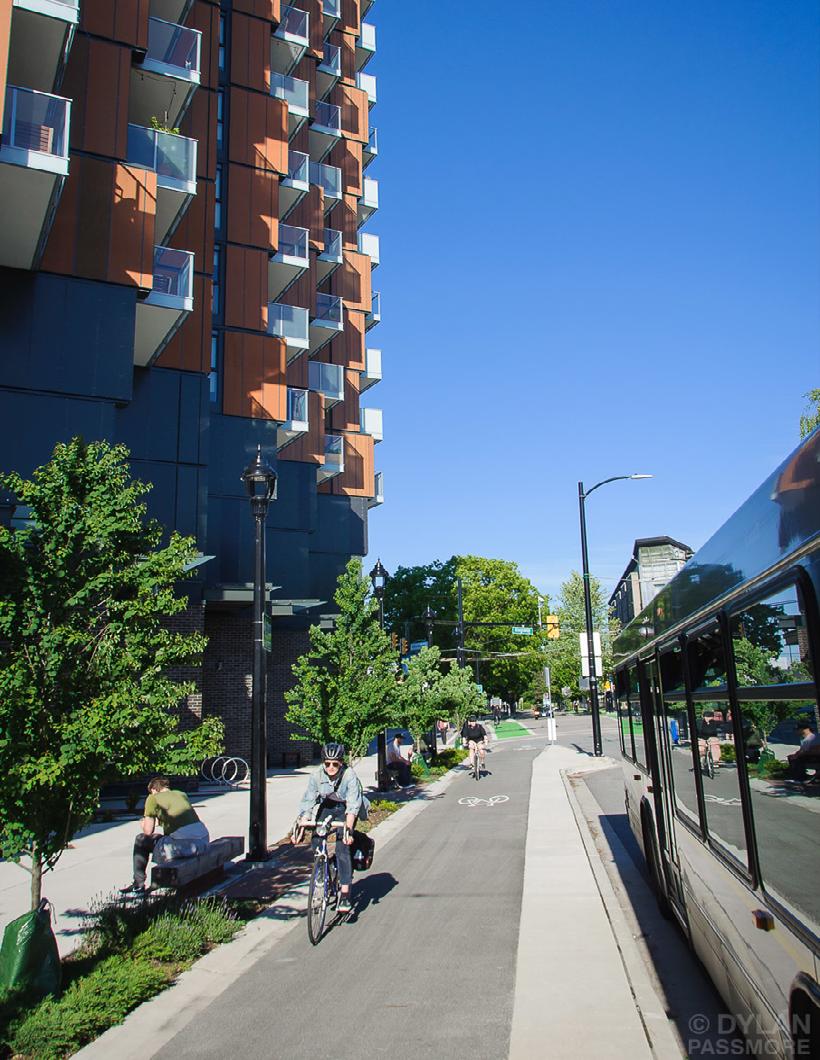
10 minute read
How We Get More People on Bikes
RESEARCH HIGHLIGHTS
The CDC’s Active People, Healthy NationSM initiative has a stated goal of getting 27 million people more physically active. In support of this goal, the League monitors progress on increasing rates of bicycling and walking in America. In 2021, this has led directly to several reports we produced on specific groups of people and topics. We hope you will check out the full reports at data.bikeleague.org.
BENCHMARKING
Bike Networks
RECONNECTING TO The New Majority
Buffer Separated Bike Lane. Source: Dylan Passmore.
BENCHMARKING INSIGHTS ON OLDER ADULTS
Approximately 45 million Americans are 65 or older, and that number is expected to grow to 73 million Americans by 2030. In partnership with AARP’s Livable Communities program, the League dove into federal data on how much older adults are biking and walking, why they do it, and how safe they are when biking and walking. We found that available data show increases in biking and walking among older adults, that older adults have some of the highest rates of biking and walking for exercise, the highest percentage of trips for shopping and errands of any age group, and that increases in bicyclist and pedestrian fatalities over the last decade have been falling particularly hard on older adults. Better infrastructure, better street lighting, lower vehicle speeds, and the use of e-bikes were identified as solutions that meet the needs of older adults for safer biking and walking.
RECONNECTING WITH THE NEW MAJORITY
In this report, the League revisits its landmark 2013 New Majority Report, which articulated the challenges faced by young adults and people of color that keep them from biking more. In the eight years since the New Majority Report, the League and bicycling movement have made strides to be more inclusive and address those challenges, but more work needs to be done. Using polling data and a focus group, we reconnect with what it takes to help the new majority and how we are situated to work with others to help everyone bike more safely and more often.
BENCHMARKING BIKE NETWORKS
The last decade has seen a rapid change in best practices for bicycle infrastructure. In this report, the League looks at some of the history about why the United States was slow to embrace bicycle infrastructure and provides an overview of current best practices. By profiling cities with higher than average rates of bike commuting and consistent growth in bike commuting over the last decade, this report provides insight on the evolving nature of bike networks and how bike networks are key to meeting the needs of people who bike.
STATE & CITY FACT SHEETS
There is a lot of data on data.bikeleague. org because we compile diverse data sources from throughout the federal government, surveys, and original research. To make that data more accessible, we will be publishing state and city fact sheets with some of the most important statistics about biking and walking. These fact sheets are meant for easy reference and for pointing people towards solutions that help more people bike and walk and do so safely.
BICYCLE FRIENDLY AMERICA
AN ODE TO GREAT BIKE PARKING
BY AMELIA NEPTUNE

Boise State University’s uncovered U racks - a perfect option for short-term bike parking (anything under 2 hours).
When most people think of bike infrastructure, they think of bike lanes or trails—the infrastructure we ride on. But bike parking is also an essential component of bike infrastructure that is too often overlooked, despite how cost effective and easy it can be to provide.
We know from polling data and personal experience that high-quality bike parking helps more people ride more often, and that the lack of secure bike parking and concerns about bike theft are a barrier for many potential bicyclists. Whether it’s biking to work or running an errand, knowing that your bike will be safe and secure when you’re ready to head home is critical. What bicyclist isn’t grateful to find businesses and daily destinations that make it easy and obvious to lock their bike safely and securely? Through our Bicycle Friendly America award applications, we see so many examples from communities, businesses, and campuses that have made this essential piece of bike infrastructure a priority. So, in this issue of things we are grateful for, here is our round-up of some favorite bike parking examples from across the country: An Ode to Great Bike Parking.
Short-term bike parking should always be easy to find and visible to “eyes on the street.” If it isn’t visible from your main entrance, there should be obvious and visible wayfinding signage to help bicyclists find it, and security cameras can be used to help keep a watchful eye if needed.
Bike racks should be intuitive to use—or provide guidance for first-time users if needed.
Covered, double-decker outdoor bike parking at Boise State University (Gold-level BFU - Boise, ID) provides even better short-term bike parking that is protected from the elements and safe, secure, and convenient for a large number of bikes in a relatively small footprint. These covered vertical racks at Boise State University have visual instructions on how to securely lock a bike to them.
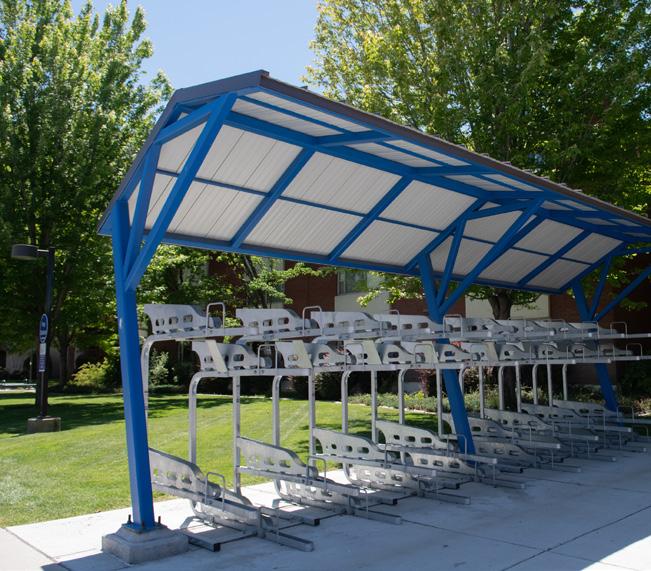
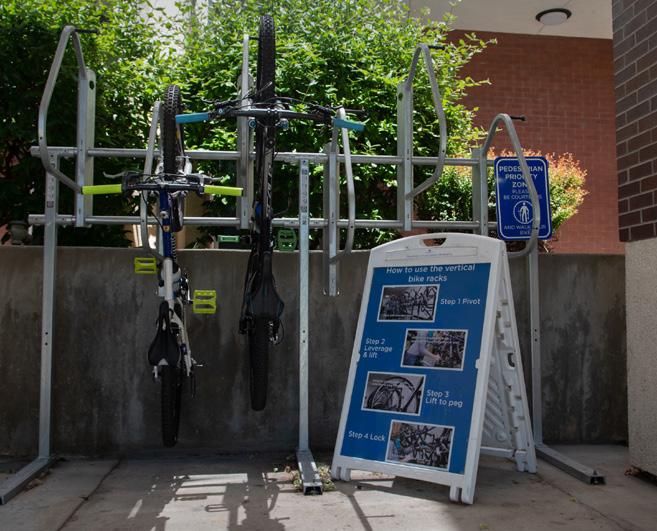
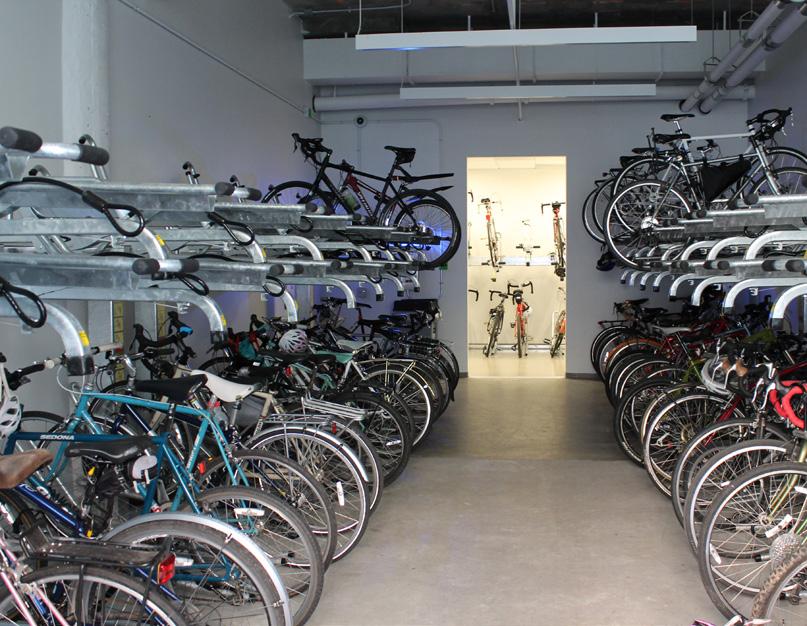

LONG-TERM BIKE PARKING
For long-term bike parking (anything more than 2 hours), bicyclists tend to prioritize security over immediate convenience. While it doesn’t need to be visible from your front door, it should still be easily accessible for all ages and abilities, and well-marked for first-time visitors.
This indoor bike room (left) features high-density double-decker parking to accommodate the many bike commuters who work at NPR (Gold-level BFB - Washington, DC). NPR’s indoor bike room is secured by key card access and is easily accessible with automatic opening doors at street level. If your bike room isn’t at street level, make sure there are ramps and/or elevators.

Language Dept’s indoor bike racks. Photo shared through Language Dept’s BFB application.
BIKE PARKING FOR BUSINESSES
Businesses that have both full-time employees as well as higher-turnover customers or visitors should provide both long-term and short-term bike parking. Smaller offices can offer indoor bike racks in common areas of the business for employees and visitors, like Language Dept (Gold-level BFB - New York, NY) headquarters and flagship store shown above.
KEEN Corporate Headquarters (Gold-level BFB - Portland, OR) provides both longterm and short-term bike parking with standard staple racks in front for customers and visitors (below left), and a secure indoor bike room for employees (below right). And yes, those are spare rubber soles from KEEN footwear used as extra wheel padding for the vertical racks.


Inset: KEEN’s bike staples in front of corporate headquarters and flagship store. Above: KEEN’s secure indoor bike parking for employees. Photos shared through KEEN’s BFB application.

Target's cargo bike parking in Arlington, VA. Photo courtesy of BikeArlington via Twitter.
Indoor bike rooms are also a wonderful opportunity to provide other end-of-trip facilities: storage lockers, repair tools and supplies, and educational/encouragement resources such as bike maps, Smart Cycling Quick Guides, and flyers or event calendars. Target Corporation (Platinum-level BFB - Minneapolis, MN) headquarters provides multiple indoor bike rooms for employees, equipped with professional-grade tools, a vending machine for spare parts and bike accessories, and air compressor. There are also subsidized mechanical services offered through Freewheel Bike Shop (Gold-level BFB) in the employee bike room for bikes to be serviced during the work day. Individual Target stores across the country, like this one (above) in Arlington, VA, are also prioritizing bikes for customers, by providing clearly marked cargo bike parking in their parking garage.
This room at 655 New York LLC-Brookfield (Silver-level BFB - Washington, DC) provides a variety of rack types with ample spacing, to accommodate a wide variety of bike sizes and types.

OUTDOOR BICYCLE LOCKERS & SIMPLE BICYCLE GARAGES
At colleges and universities, as well as larger corporate campuses, we frequently see outdoor bicycle lockers and simple bicycle garages distributed across the campus, offering protection from the elements and from bike theft, while still offering convenience and accessibility to a more fluid biking population. Note that in all four examples below, additional short-term racks are provided nearby to provide overflow capacity and to accommodate short-term visitors who may not have access to the bike cages or lockers.

MIT (Silver-level BFU - Cambridge, MA) bike cage gets lots of use. Photo shared through MIT’s BFU application. Facebook Headquarters (Platinum-level BFB - Menlo Park, CA) bike cage. Photo shared through Facebook headquarters BFB application.


PayPal Headquarters (Gold-level BFB - La Vista, NE) bike lockers. Photo shared through PayPal’s BFB application. Northern Arizona University (Gold-level BFU - Flagstaff, AZ) bike locker wraps. Photo shared through Northern Arizona University’s BFU application.

Double-decker parking on one side can accommodate a higher volume, while simple U-racks on the other side can accommodate a wider variety of cycle types and sizes.

Simple bike garages like this one can be found across the campus at Portland State University (Platinum-level BFU - Portland, OR).
In urban areas, we’re starting to see similar bike parking models become publicly available such as the innovative modular Oonee pods (below) in New York City, which provide safe, secure, and convenient public bike parking that can be located on almost any city street.

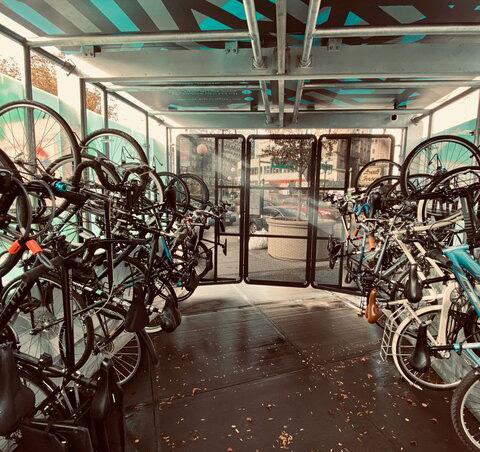
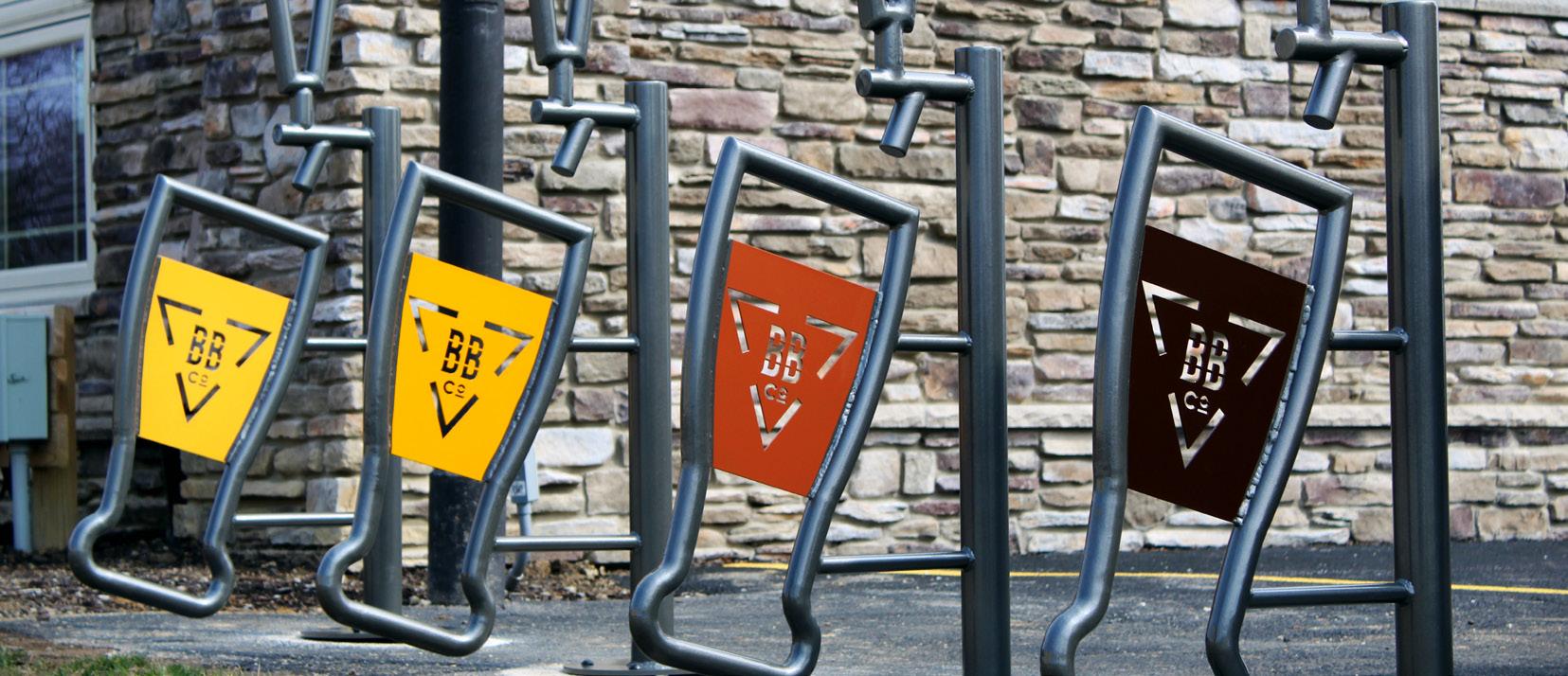
PEACE OF MIND
One of our favorite bike parking details from a recent BFB application is Brokerage Brewery Co (Bronzelevel BFB West Lafayette, IN). Their beer tap themed racks (above) can be monitored by customers inside through a live stream on the brewery’s website: brokeragebrewing.com/bikes.

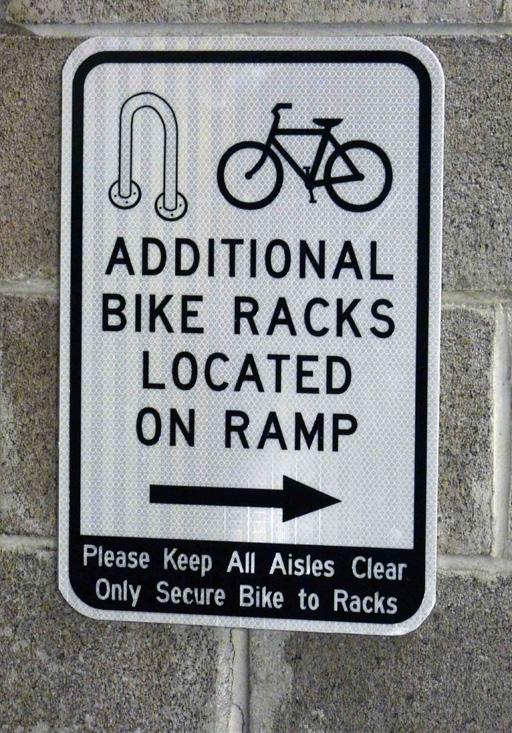
EASY WAYFINDING
Wayfinding signage should be clear and specific, like this example at left from the City and County of Denver (Silver BFB and Silver BFC - Denver, CO) which uses wayfinding signage to point to their overflow bike parking. If you’re a business or destination providing bike parking to customers, visitors, or the general public, there should always be a map, photo, and description of your bike parking location(s) readily available on your website, even if that bike parking is right out front, so that anyone deciding whether or how to get to your destination knows exactly what to expect if they arrive on a bike.
When bike parking isn’t visible from your front entrance, it is important to make sure bicyclists know exactly where to find it.
BIKE VALET
Another incredible bike parking solution we’ve seen is valet bike parking services at campuses and urban areas with high bike commuter rates. At Oregon Health & Science University (Platinum-level BFB and Gold-level BFU - Portland, OR), free bike valet services are offered by partner organization Go By Bike, Monday-Friday from 6am-7:30pm (below, inset). Bike commuters can rent bike parking spaces and storage lockers during the workday at Santa Monica Bike Center (Platinum-level BFB - Santa Monica, CA) and there is even free 2-hour valet bike parking available to residents and visitors (below).

PUTTING IT INTO PRACTICE

Want to learn the basics of long or short-term bike parking so your community, business, or university can be more accommodating to all bicyclists? This Fall we hosted two great webinars on exactly these topics in partnership with bike parking experts Dero. Find the webinar recordings at the links below:
LONG-TERM BIKE PARKING WEBINAR
https://bit.ly/LongTermBikeParking
SHORT-TERM BIKE PARKING WEBINAR
https://bit.ly/ShortTermBikeParking







